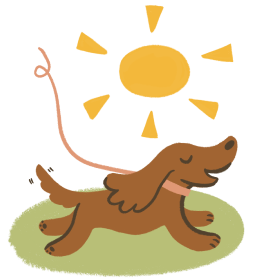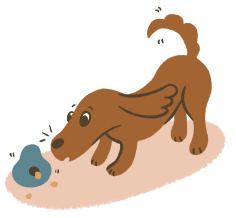How light and exercise can boost your pet’s health

By Dr Edward Bassingthwaighte, Holistic Veterinarian
Light and wellbeing
The kind of light, how often, and how long your pets are exposed to it, profoundly affects wellbeing and vitality. All mammals have biological rhythms, physiological clocks that are affected by the colour or spectrum of light that comes into their body; sensed by the eyes, the skin, and the whole being.
This is the circadian rhythm, a changing pattern of mental, physical, and behavioural activities throughout the day/night cycle. This makes your pets (and you) ready for the things that need to happen - waking, eating, sleeping, times of increased alertness and activity, times of relaxation, rest, and regeneration.

The circadian rhythm primarily manages the sleep/wake cycle, but it also affects and modulates many functions, processes, and activities throughout all the biological systems of the body. The circadian rhythms in your pet's body are entrainable - this means that they can be reset by exposure to light or temperature. This resetting can be in a good way, increasing health and vitality, or in a bad way, which is a drain on your pet’s vitality.
This process of the circadian rhythms is important for animals to coordinate their activities with the day/night cycle, and it also regulates and coordinates many internal processes - the activities of life in the body. We see regular patterns of core body temperature, brain wave activity, hormone production, cell regeneration, and other biological activities. These are all expressions of the circadian rhythm.
The primary stimulus that regulates this deep, important biorhythm, is light coming into your pet’s eyes. The colour or spectrum of the light is important. The light in the morning wakes your pets up by causing the body to break down the primary hormone that triggers sleep - melatonin.
The spectrum of light in the morning is warm (yellow/orange/red) - this shifts as the sun rises, until in the middle of the day, the spectrum is cooler (blue). The bluer the light, the more melatonin is broken down- so your pets are more alert in the daytime. Then the evening light shifts back to a warm spectrum, and melatonin begins to build up slowly in the body.

After sunset, your pet’s pineal gland produces more and more melatonin, preparing your pet for deep, restful, regenerative sleep. Even short bursts of light can affect the circadian clock in your pet’s body. A large problem with artificial lighting, especially LED lighting (and this includes all screens/devices) is that it often has a strong amount of the blue light spectrum.
Any light from LED lighting or screens (TV, computers, phones, tablets) after sunset will instantly signal your pet's body to break down melatonin. This is going to be a major drain on vitality in the long term because the depth and quality of sleep will be adversely affected. If you have warm LED lighting, that’s a lot better, but still not ideal. Even with warm spectrum lighting after dark, the intensity of the light still has a disruptive effect on the circadian rhythm.
Ideally, you’d only expose your pets to very red lighting after sunset. And you’d also make sure your pets get exposure to raw, unfiltered sunlight for a bare minimum of at least 10-15 minutes in the early morning, middle of the day, and late evening. This helps cue your pet's biology into a healthy circadian rhythm. More healthy sun exposure is better (as long as you’re not overexposing white pets who may be more prone to skin cancers).
Our pets, and us, are NOT adapted to cope with artificial light, especially artificial light and light pollution after sunset. It has subtle but important adverse effects on vitality and well-being. There are lighting systems coming onto the market now that can mimic the spectral shift in sunlight during the day. You can also get apps for your devices and computers to shift the light from the screens into the warmer spectra in the mornings, evenings and nights. Or wear blue blocker glasses.

Exercise and relaxation
Your pets will thrive with age, breed, size and climate-appropriate exercise. You can time your pet’s exercise to align with healthy raw sunlight exposure. Then you’ll be creating a win-win for you and your pets - because guess what? You’ll then bet getting healthy raw sunlight exposure, which helps your well-being (and this benefits your pets too).
I recommend minimising high-impact, high-arousal exercise/play. No more than 5-10 minutes of ball play once or twice daily. Many humans have a bias towards stimulating their dogs into states of excitement and arousal. Some of this is good, too much can lead to problems with physical injury, anxiety, over-excitement and so on.
It’s really important to do plenty of calm, relaxed activities and exercise - scent-based games and sports, steady walks, maybe steady jogging and running. You need to teach dogs how to switch off and relax. A healthy happy dog should spend 70-80% of their day (24-hour period) in healthy relaxation and sleep.
If you have a dog with high drive or any kind of anxiety issues, you’ll need to take time to teach and support healthy relaxation. An ‘on your bed and stay’ command can be helpful, as can crate training. I find the relaxing therapeutic touch of the Whole Energy Body Balance for Pets work can teach and support a healthy, strong ability to regulate into and rest in states of healthy relaxation. I call this ‘building an off switch’. If you have a dog who is hypervigilant, never settles, never sleeps deeply, then this is an anxious dog, and over time, this state of being continually ‘switched on’ erodes vitality.

There are so many calming and connecting games you can play with your dogs:
- Sniffing out treats,
- Rewarding relaxed behaviour (I bolded that for a reason!),
- The ‘leave it’ command (wait until the dog self-regulates into obvious relaxation before interacting with that toy again)
- Reading aloud to your dogs (sounds silly, highly effective!)
- Puzzle toys
- Obedience training (you need to stay calm and grounded too)
Anything that builds focus, makes the dog think and doesn’t escalate their excitement or arousal is going to be helpful. And the more you can do these activities outside, and preferably in nature (parks if in the city) will also expose your dog the light medicine they need to keep their biology as healthy and as vital as possible.
See my article 'How to help your pet live a long and happy life' for more tips.
About the Author - Dr Edward Bassingthwaighte.

Dr Edward Bassingthwaighte is a holistic veterinarian, and a world-leading expert in silent pain in pets. Dr Edward is passionate about fresh raw whole foods for dogs. He is the founder of the Whole Energy Body Balance method- a profoundly healing bodywork modality for pet parents and pet wellness professionals to relieve silent pain, anxiety and trauma in pets. Join Dr Edward's free masterclass on silent pain in pets here.
